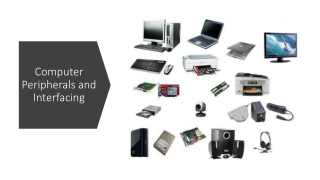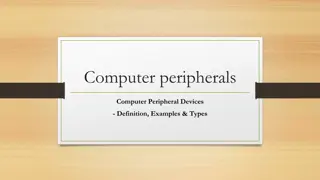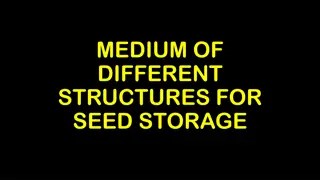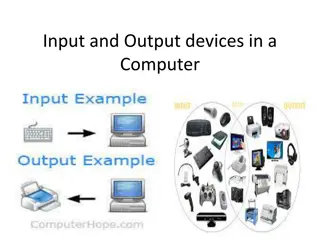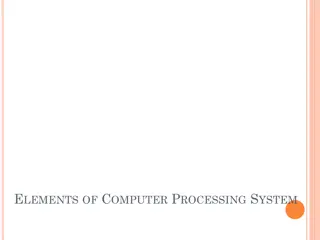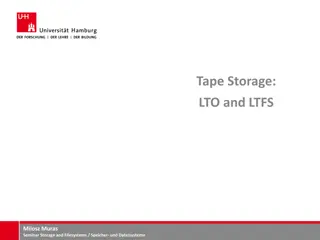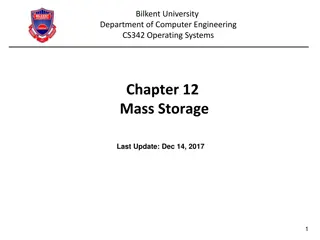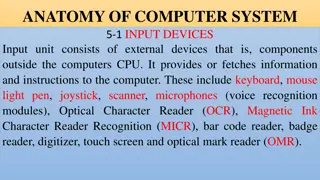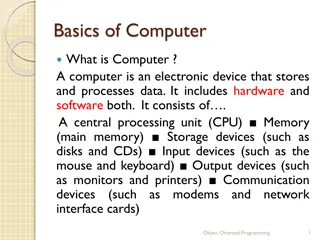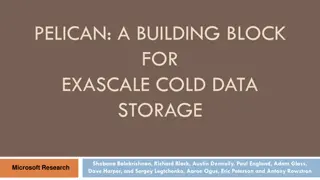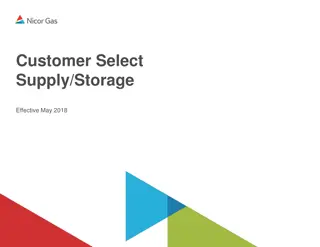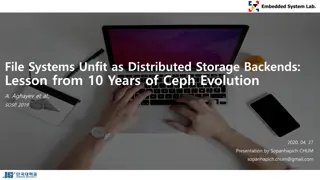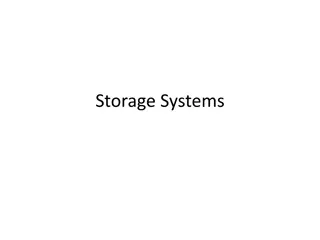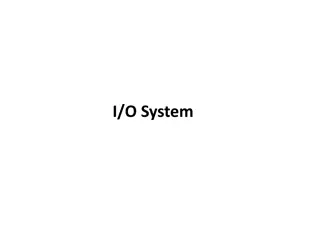Storage Devices in Computer Systems
This content provides an in-depth look at storage devices used in computer systems, covering topics such as hard drives, RAID, SSDs, addressing and geometry of hard drives, disk interfaces, types of delays with disks, and how to calculate transfer time. It explores the components, functionalities, and performance aspects of storage devices essential for understanding computer systems architecture and operation.
Download Presentation

Please find below an Image/Link to download the presentation.
The content on the website is provided AS IS for your information and personal use only. It may not be sold, licensed, or shared on other websites without obtaining consent from the author.If you encounter any issues during the download, it is possible that the publisher has removed the file from their server.
You are allowed to download the files provided on this website for personal or commercial use, subject to the condition that they are used lawfully. All files are the property of their respective owners.
The content on the website is provided AS IS for your information and personal use only. It may not be sold, licensed, or shared on other websites without obtaining consent from the author.
E N D
Presentation Transcript
CS 5600 Computer Systems Lecture 8: Storage Devices
Hard Drives RAID SSD 2
Addressing and Geometry Externally, hard drives expose a large number of sectors (blocks) Typically 512 or 4096 bytes Individual sector writes are atomic Multiple sectors writes may be interrupted (torn write) Drive geometry Sectors arranged into tracks A cylinder is a particular track on multiple platters Tracks arranged in concentric circles on platters A disk may have multiple, double-sided platters Drive motor spins the platters at a constant rate Measured in revolutions per minute (RPM) 5
Geometry Example Sector Three tracks 12 13 11 24 23 25 10 14 32 22 9 31 33 26 15 Rotation Read head 8 21 30 34 27 0 29 35 20 7 16 1 Seeks across the various tracks 28 17 19 6 2 18 5 3 4 Outer tracks hold more data One platter 6
Common Disk Interfaces ST-506 ATA IDE SATA Ancient standard Commands (read/write) and addresses in cylinder/head/sector format placed in device registers Recent versions support Logical Block Addresses (LBA) SCSI (Small Computer Systems Interface) Packet based, like TCP/IP Device translates LBA to internal format (e.g. c/h/s) Transport independent USB drives, CD/DVD/Bluray, Firewire iSCSI is SCSI over TCP/IP and Ethernet 7
Types of Delay With Disks Long delay Three types of delay 1. Rotational Delay Time to rotate the desired sector to the read head Related to RPM 2. Seek delay Time to move the read head to a different track 3. Transfer time Time to read or write bytes 12 13 11 24 23 25 10 14 32 22 9 31 33 26 15 8 21 30 34 27 0 29 35 20 7 16 1 28 17 19 6 2 18 5 3 4 Short delay Track skew: offset sectors so that sequential reads across tracks incorporate seek delay 8
How To Calculate Transfer Time Transfer time TI/O = Tseek + Trotation + Ttransfer Cheetah 15K.5 Barracuda Capacity 300 GB 1 TB RPM 15000 7200 Assume we are transferring 4096 bytes Avg. Seek 4 ms 9 ms Max Transfer 125 MB/s 105 MB/s TI/O = 4 ms + 1 / (15000 RPM / 60 s/M / 1000 ms/s) / 2 + (4096 B / 125 MB/s * 1000 ms/s / 220 MB/B) TI/O = 4 ms + 2ms + 0.03125 ms 6 ms Cheetah TI/O = 9 ms + 1 / (7200 RPM / 60 s/M / 1000 ms/s) / 2 + (4096 B / 105 MB/s * 1000 ms/s / 220 MB/B) TI/O = 9 ms + 4.17 ms + 0.0372 ms 13.2 ms Barracuda 9
Sequential vs. Random Access Rate of I/O RI/O = transfer_size / TI/O Access Type Transfer Size Cheetah 15K.5 Barracuda TI/O RI/O TI/O RI/O 6 ms 13.2 ms Random 4096 B 0.66 MB/s 0.31 MB/s 800 ms 950 ms Sequential 100 MB 125 MB/s 105 MB/s Max Transfer Rate 125 MB/s 105MB/s Random I/O results in very poor disk performance! 10
Caching Many disks incorporate caches (track buffer) Small amount of RAM (8, 16, or 32 MB) Read caching Reduces read delays due to seeking and rotation Write caching Write back cache: drive reports that writes are complete after they have been cached Possibly dangerous feature. Why? Write through cache: drive reports that writes are complete after they have been written to disk Today, some disks include flash memory for persistent caching (hybrid drives) 11
Disk Scheduling Caching helps improve disk performance But it can t make up for poor random access times Key idea: if there are a queue of requests to the disk, they can be reordered to improve performance First come, first serve (FCFC) Shortest seek time first (SSTF) SCAN, otherwise know as the elevator algorithm C-SCAN, C-LOOK, etc. 12
FCFS Scheduling Most basic scheduler, serve requests in order Head starts at block 53 Queue: 98, 183, 37, 122, 14, 124, 65, 67 Lot s of time spent seeking Total movement: 640 cylinders 13
SSTF Scheduling Idea: minimize seek time by always selecting the block with the shortest seek time Head starts at block 53 Queue: 98, 183, 37, 122, 14, 124, 65, 67 The good: SSTF is optimal, and it can be easily implemented! The bad: SSTF is prone to starvation Total movement: 236 cylinders 14
SCAN Example Head sweeps across the disk servicing requests in order Head starts at block 53 Queue: 98, 183, 37, 122, 14, 124, 65, 67 The bad: average access times are less for requests at high and low addresses The good: reasonable performance, no starvation Total movement: 236 cylinders 15
C-SCAN Example Like SCAN, but only service requests in one direction Head starts at block 53 Queue: 98, 183, 37, 122, 14, 124, 65, 67 The bad: worse performance than SCAN The good: fairer than SCAN Total movement: 382 cylinders 16
C-LOOK Example Peek at the upcoming addresses in the queue Head only goes as far as the last request Head starts at block 53 Queue: 98, 183, 37, 122, 14, 124, 65, 67 Total movement: 322 cylinders 17
Implementing Disk Scheduling We have talked about several scheduling problems that take place in the kernel Process scheduling Page swapping Where should disk scheduling be implemented? OS scheduling OS can implement SSTF or LOOK by ordering the queue by LBA However, the OS cannot account for rotation delay On-disk scheduling Disk knows the exact position of the head and platters Can implement more advanced schedulers (SPTF) But, requires specialized hardware and drivers 18
Command Queuing Feature where a disk stores of queue of pending read/write requests Called Native Command Queuing (NCQ) in SATA Disk may reorder items in the queue to improve performance E.g. batch operations to close sectors/tracks Supported by SCSI and modern SATA drives Tagged command queuing: allows the host to place constraints on command re-ordering 19
Hard Drives RAID SSD 20
Beyond Single Disks Hard drives are great devices Relatively fast, persistent storage Shortcomings: How to cope with disk failure? Mechanical parts break over time Sectors may become silently corrupted Capacity is limited Managing files across multiple physical devices is cumbersome Can we make 10x 1 TB drives look like a 10 TB drive? 21
Redundant Array of Inexpensive Disks RAID: use multiple disks to create the illusion of a large, faster, more reliable disk Externally, RAID looks like a single disk i.e. RAID is transparent Data blocks are read/written as usual No need for software to explicitly manage multiple disks or perform error checking/recovery Internally, RAID is a complex computer system Disks managed by a dedicated CPU + software RAM and non-volatile memory Many different configuration options (RAID levels) 22
Example RAID Controller SATA ports RAM CPU Non-volatile storage 23
RAID 0: Striping Key idea: present an array of disks as a single large disk Maximize parallelism by striping data cross all N disks Disk 0 Disk 1 Disk 2 Disk 3 Sequential Random accesses are naturally spread Data block = 512 bytes accesses spread across all drives 0 4 8 12 1 5 9 13 2 6 10 14 3 7 11 15 Stripe over all drives 24
Addressing Blocks How do you access specific data blocks? Disk = logical_block_number % number_of_disks Offset = logical_block_number / number_of_disks Example: read block 11 11 % 4 = Disk 3 11 / 4 = Physical Block 2 (starting from 0) Disk 0 Disk 1 Disk 2 Disk 3 0 4 8 12 1 5 9 13 2 6 10 14 3 7 11 15 25
Chunk Sizing Chunk size = 1 block Disk 0 Disk 1 Disk 2 Disk 3 0 4 8 12 1 5 9 13 2 6 10 14 3 7 11 15 Chunk size impacts array performance Smaller chunks greater parallelism Big chunks reduced seek times Typical arrays use 64KB chunks Disk 0 Disk 1 Disk 2 Disk 3 0 1 8 9 2 3 10 11 4 5 12 13 6 7 14 15 Chunk size = 2 block 26
Measuring RAID Performance (1) As usual, we focus on sequential and random workloads Assume disks in the array have sequential access time S 10 MB transfer S = transfer_size / time_to_access 10 MB / (7 ms + 3 ms + 10 MB / 50 MB/s) = 47.62 MB/s Average seek time 7 ms Average rotational delay 3 ms Transfer rate 50 MB/s 27
Measuring RAID Performance (2) As usual, we focus on sequential and random workloads Assume disks in the array have random access time R 10 KB transfer R = transfer_size / time_to_access 10 KB / (7 ms + 3 ms + 10 KB / 50 MB/s) = 0.98 MB/s Average seek time 7 ms Average rotational delay 3 ms Transfer rate 50 MB/s 28
Analysis of RAID 0 Capacity: N All space on all drives can be filled with data Reliability: 0 If any drive fails, data is permanently lost Sequential read and write: N * S Full parallelization across drives Random read and write: N * R Full parallelization across all drives 29
RAID 1: Mirroring RAID 0 offers high performance, but zero error recovery Key idea: make two copies of all data Disk 0 Disk 1 0 1 2 3 0 1 2 3 30
RAID 0+1 and 1+0 Examples 0+1 1+0 Mirror Stripe Stripe Stripe Mirror Mirror Disk 0 Disk 1 Disk 2 Disk 3 Disk 0 Disk 1 Disk 2 Disk 3 0 2 4 6 1 3 5 7 0 2 4 6 1 3 5 7 0 2 4 6 0 2 4 6 1 3 5 7 1 3 5 7 Combines striping and mirroring Superseded by RAID 4, 5, and 6 31
Analysis of RAID 1 (1) Capacity: N / 2 Two copies of all data, thus half capacity Reliability: 1 drive can fail, sometime more If you are lucky, N / 2 drives can fail without data loss Disk 0 Disk 1 Disk 2 Disk 3 0 2 4 6 1 3 5 7 0 2 4 6 1 3 5 7 32
Analysis of RAID 1 (2) Sequential write: (N / 2) * S Two copies of all data, thus half throughput Sequential read: (N / 2) * S Half of the read blocks are wasted, thus halving throughput Disk 0 Disk 1 Disk 2 Disk 3 0 2 4 6 1 3 5 7 0 2 4 6 1 3 5 7 Each skipped block is wasted 33
Analysis of RAID 1 (3) Random read: N * R Best case scenario for RAID 1 Reads can parallelize across all disks Random write: (N / 2) * R Two copies of all data, thus half throughput Disk 0 Disk 1 Disk 2 Disk 3 0 2 4 6 1 3 5 7 0 2 4 6 1 3 5 7 34
The Consistent Update Problem Mirrored writes should be atomic All copies are written, or none are written However, this is difficult to guarantee Example: power failure Many RAID controllers include a write-ahead log Battery backed, non-volatile storage of pending writes RAID Controller Cache Disk 0 Disk 1 Disk 2 Disk 3 0 2 4 6 1 3 5 7 0 2 4 6 1 3 5 7 35
Decreasing the Cost of Reliability RAID 1 offers highly reliable data storage But, it uses N / 2 of the array capacity Can we achieve the same level of reliability without wasting so much capacity? Yes! Use information coding techniques to build light- weight error recovery mechanisms 36
RAID 4: Parity Drive Disk 4 Disk 0 Disk 1 Disk 2 Disk 3 P0 P1 P2 P3 0 4 8 12 1 5 9 13 2 6 10 14 3 7 11 15 Disk N only stores parity information for the other N-1 disks Disk 0 Disk 1 Disk 2 Disk 3 Disk 4 0 0 1 1 0 ^ 0 ^ 1 ^ 1 = 0 Parity calculated using XOR 0 1 0 0 0 ^ 1 ^ 0 ^ 0 = 1 1 1 1 1 1 ^ 1 ^ 1 ^ 1 = 0 0 1 1 1 0 ^ 1 ^ 1 ^ 1 = 1 37
Updating Parity on Write How is parity updated when blocks are written? 1. Additive parity Disk 0 Disk 1 Disk 2 Disk 3 Disk 4 1 0 0 ^ 0 ^ 1 ^ 1 = 0 0 ^ 0 ^ 0 ^ 1 = 1 0 0 1 Read other blocks Update parity block 2. Subtractive parity Disk 0 Disk 1 Disk 2 Disk 3 Disk 4 0 1 0 0 1 1 0 ^ 0 ^ 1 ^ 1 = 0 Pnew = Cold ^ Cnew ^ Pold 38
Random Writes and RAID 4 Disk 4 Disk 0 Disk 1 Disk 2 Disk 3 All writes must update the parity drive, causing serialization :( P0 P1 P2 P3 0 4 8 12 1 5 9 13 2 6 10 14 3 7 11 15 Random writes in RAID 4 1. Read the target block and the parity block 2. Use subtraction to calculate the new parity block 3. Write the target block and the parity block RAID 4 has terrible write performance Bottlenecked by the parity drive 39
Analysis of RAID 4 Capacity: N 1 Space on the parity drive is lost Reliability: 1 drive can fail Sequential Read and write: (N 1) * S Parallelization across all non-parity blocks Random Read: (N 1) * R Reads parallelize over all but the parity drive Random Write: R / 2 Writes serialize due to the parity drive Each write requires 1 read and 1 write of the parity drive, thus R / 2 40
RAID 5: Rotating Parity Disk 4 Disk 0 Disk 1 Disk 2 Disk 3 Parity blocks are spread over all N disks P0 4 9 14 0 5 10 15 1 6 11 P3 2 7 3 P1 8 13 P2 12 Disk 0 Disk 1 Disk 2 Disk 3 Disk 4 0 0 1 1 0 ^ 0 ^ 1 ^ 1 = 0 1 0 0 0 ^ 1 ^ 0 ^ 0 = 1 0 1 1 1 ^ 1 ^ 1 ^ 1 = 0 1 1 1 0 ^ 1 ^ 1 ^ 1 = 1 0 1 1 41
Random Writes and RAID 5 Disk 4 Disk 0 Disk 1 Disk 2 Disk 3 Unlike RAID 4, writes are spread roughly evenly across all drives P0 4 9 14 0 5 10 15 1 6 11 P3 2 7 3 P1 8 13 P2 12 Random writes in RAID 5 1. Read the target block and the parity block 2. Use subtraction to calculate the new parity block 3. Write the target block and the parity block Thus, 4 total operations (2 reads, 2 writes) Distributed across all drives 42
Analysis of Raid 5 Capacity: N 1 [same as RAID 4] Reliability: 1 drive can fail [same as RAID 4] Sequential Read and write: (N 1) * S [same] Parallelization across all non-parity blocks Random Read: N * R [vs. (N 1) * R] Unlike RAID 4, reads parallelize over all drives Random Write: N / 4 * R [vs. R / 2 for RAID 4] Unlike RAID 4, writes parallelize over all drives Each write requires 2 reads and 2 write, hence N / 4 43
Comparison of RAID Levels R random access speed D latency to access a single disk N number of drives S sequential access speed RAID 0 RAID 1 RAID 4 RAID 5 Capacity N N / 2 N 1 N 1 Reliability 0 1 (maybe N / 2) 1 1 Sequential Read N * S (N / 2) * S (N 1) * S (N 1) * S Throughput Sequential Write N * S (N / 2) * S (N 1) * S (N 1) * S Random Read N * R N * R (N 1) * R N * R Random Write N * R (N / 2) * R R / 2 (N / 4) * R Latency Read D D D D Write D D 2 * D 2 * D 44
RAID 6 Disk 4 Disk 0 Disk 1 Disk 2 Disk 3 P01 3 7 11 0 4 8 1 5 2 P00 P11 6 10 Two parity blocks per stripe P10 P21 9 P20 P31 P30 Any two drives can fail N 2 usable capacity No overhead on read, significant overhead on write Typically implemented using Reed-Solomon codes 45
Choosing a RAID Level Best performance and most capacity? RAID 0 Greatest error recovery? RAID 1 (1+0 or 0+1) or RAID 6 Balance between space, performance, and recoverability? RAID 5 46
Other Considerations Many RAID systems include a hot spare An idle, unused disk installed in the system If a drive fails, the array is immediately rebuilt using the hot spare RAID can be implemented in hardware or software Hardware is faster and more reliable But, migrating a hardware RAID array to a different hardware controller almost never works Software arrays are simpler to migrate and cheaper, but have worse performance and weaker reliability Due to the consistent update problem 47
Hard Drives RAID SSD 48
Beyond Spinning Disks Hard drives have been around since 1956 The cheapest way to store large amounts of data Sizes are still increasing rapidly However, hard drives are typically the slowest component in most computers CPU and RAM operate at GHz PCI-X and Ethernet are GB/s Hard drives are not suitable for mobile devices Fragile mechanical components can break The disk motor is extremely power hungry 49
Solid State Drives NAND flash memory-based drives High voltage is able to change the configuration of a floating-gate transistor State of the transistor interpreted as binary data Data is striped across all chips Flash memory chip 50



